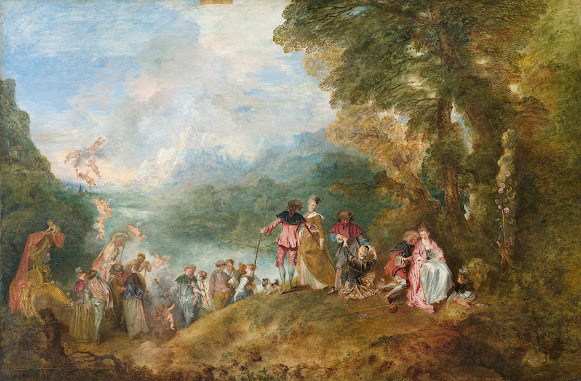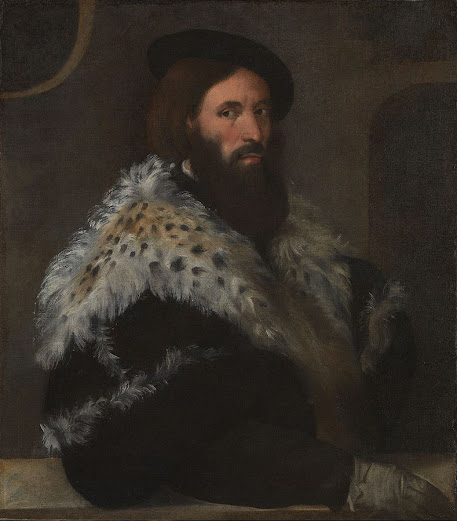Classical Analysis
(The Embarkation for Cythera, by Jean-Antoine Watteau, 1717, Berlin)
The Embarkation for Cythera is a famous piece of fête galante artistry. It sits at the end of the Baroque era of painting, where artists began to dismiss some of their restrictions and dip into the rococo style. This piece favors color greatly over the strong lines of the Baroque, giving an entirely different tone to the otherwise similar style of landscape painting. The Embarkation for Cythera depicts a romantic gathering with several different couples, with many dancing. They are flanked by a statue of Venus, the roman goddess of love, and a smattering of Cherubs. Importantly, the painting was received as frivolous, and was part of the push-back argument against immoral artistry in the late Baroque/Classical era.
Aesthetically, I find myself unable to follow this piece without the use of a zooming tool, simply because of how blended each part of the painting is. I cannot really distinguish between the background denizens, all packed into such a confined portion of the painting.
(Cornelia, Mother to the Gracchi, Pointing to Her Children as Her Treasures, by Angelica Kauffman, 1785)
Here we have an example of the aforementioned moral pushback. Cornelia, Mother to the Gracchi, Pointing to Her Children as Her Treasures is a neoclassical piece that depicts Cornelia, the daughter of a prominent Roman general, as well as her children and another woman. The painting regains some of the prominent lines of the Baroque paintings, but loses the dark shadows of Tenebrism. The resulting painting, yellow sunset included, paints a typical Neoclassical picture. The so-called frivolity, as well as most of the emotion of Rococo, has been vanquished.
I find this piece to be easy to understand, especially with the help of the title. The only problem is that I'm left asking myself, "what's the point?" I feel as though there isn't any story behind a painting such as this, compared even to its contemporaries in the Neoclassical.
It is hard to make a statement on the morality of Classical (and more specifically Rococo) art without The Swing by Jean-Honoré Fragonard making an appearance. Depicted here is a girl who has contrived to give her lover a timely glance while she goes back and forth on a garden swing. The main opposition to this piece, which was known to be Fragonard's most famous, was that it showed humanity at its most indecent. There are strong Baroque elements, including the diagonal line drawn between the lover in the bush and the second rope of the swing, and the dark shadows in the corners. However, the bright pink centerpiece and sprawling greenery firmly places this into the Rococo style.


.jpg)

_-_Google_Art_Project.jpg)
Les hazards here de l`escarpolette (The Swing) was created in France by Jean-Honore Fragonard and measures 81x64.2 cm oil on canvas and is currently housed at the Wallace Collection, London, UK. In the summer of 2021, the painting underwent cautious cleaning and restoration. The painting is full of countless details, such as trees, flowerbeds, cloud-covered sky, overgrown fountains, and the sculpture of Cupid overlooking the scene, hushing the viewer in the view of the delicate situation.
ReplyDeletehttps://www.wallacecollection.org/explore/collection/search-the-collection/les-hazards-heureux-de-lescarpolette-swing/
Hello I really enjoyed reading about how art changed from the Baroque to Rococo periods. It was cool to see how you compared different artworks and talked about how people reacted to them. I especially liked how you looked closely at each painting's style and what it meant, and the questions they raised about what stories the art tells and how moral it is.
ReplyDeleteWow! 'The Swing' has some of the most beautiful use of colors that I have seen in a painting, especially the pink, great choice! I like how you mentioned the opposition to the piece at the time to tie in with the theme as well. One thing on the art elements side that stands out to me on 'The Swing' is the natural patterns used to depict the flora in this painting. Great post thanks!
ReplyDelete